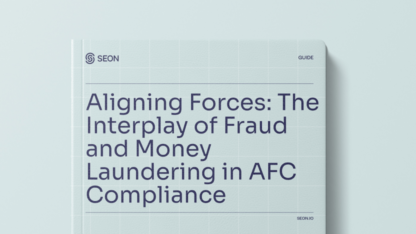As a neobank your digital onboarding is designed to be fast, frictionless, and secure – but we know you can’t afford to cut corners with due diligence.
This creates a double bind: On the one hand, you need to grow your customer base fast, offering an efficient way to open an account or apply for a financial product. On the other hand, being too lax at the onboarding stage opens the door to bank account fraud, fines, and a damaged reputation.
With Statista predicting a user penetration rate of 4.1% by 2026 – along with 376.9 million forecasted users by 2027 – offering the best and safest digital onboarding processes is paramount.
Let’s take a look at how this can be achieved.
Discover how to revolutionize your digital onboarding experience—download our guide to balance efficiency, security, and customer satisfaction today!
Read guide
Explaining Digital Onboarding in Digital Banks
In banking, digital onboarding is an automated process that gives customers access to financial products and services. This may include opening a bank account, taking out a loan, or simply creating an account with a digital bank or neobank.
The reason it is separate from the traditional onboarding process is that digital onboarding is done solely online. It is designed to be fast, frictionless, easy to do, and secure – but normally still needs to comply with the same laws and regulations that apply offline.
Why Is Digital Onboarding a Challenge for Banks?
Digital onboarding is the decisive moment when a bank accepts a new customer. Unfortunately, not all of these individuals have the best intentions at heart. Fraudsters, cybercriminals, and other bad actors have every incentive to open fraudulent bank accounts online, aiming to launder money, take loans they won’t repay, or fund illicit activities.
To make matters worse, every failure to prevent bad customers from opening bank accounts is also a compliance risk. The banking sector has always been under heavy scrutiny from government agencies which impose strict KYC and AML due diligence checks and punish those organizations that don’t adhere to them.
This creates a double bind for banks and neobanks: On the one hand, they want to grow their customer base as quickly as possible, offering the most pleasant and smooth onboarding journey. On the other, being too lax at the onboarding stage will open the door to fraud, fines, and a damaged business reputation.
How Is Digital Onboarding Changing Banking?
Compared to traditional customer account creation in a brick-and-mortar bank, online-only digital onboarding has both pros and cons.
In the pros section, you will find that digital onboarding can be faster, cheaper, and better at scaling. You can automate most of the processes with very little need for human intervention, which is why neobanks and challenger banks have built their entire business model on the practice.
It’s also much more convenient for customers – especially younger ones who grew up in the always-on economy. The lack of friction and 24/7 availability has proven to be a hit with Gen Z and millennials who eschew traditional banks for leaders like Monzo, Revolut, or Wise.
All of the above has inspired traditional banks to follow suit and increasingly move their operations online.
Downsides to digital onboarding include having to create an audit trail, ensuring your tech infrastructure is robust enough, and reconsidering your risk strategy – the latter of which we’ll cover below.
How to Reduce Risk in Digital Onboarding
Reducing onboarding risks for digital banks requires a multifaceted approach that combines advanced technology with intelligent processes. Tools like AI, machine learning, and automated risk scoring systems enable digital banks to streamline onboarding while effectively minimizing fraud and operational costs. Pre-KYC checks and data enrichment are critical strategies, allowing banks to filter out fraudulent users early, before they progress to costly verification stages. By leveraging diverse data sources such as IP addresses, device fingerprints, and email histories, banks can build comprehensive digital profiles, ensuring only legitimate users advance through the onboarding process.
Continuous monitoring and adaptation further enhance fraud prevention, enabling digital banks to address evolving threats in real time. AI-powered systems dynamically analyze user behavior, digital footprints, and transaction patterns, allowing for instant risk assessments and flagging suspicious activity without compromising the user experience. By automating risk assessment and integrating proactive security measures, digital banks can maintain a secure onboarding process that balances efficiency, customer satisfaction, and regulatory compliance.
3 Rules for Safer Digital Onboarding in Banking
Now we know the three questions you should be asking to lower risk, now let’s look at the three risk rules you need to apply.
#1: Flag Users With No Socials
Every app and online account you use creates a digital footprint that tells those who monitor it how likely it is you’re a legitimate customer. The average customer has a strong digital footprint with access to various social media accounts and apps, like Airbnb and Gmail.
Would no social media presence mean an account holder is a fraudster? Not always, but it is a strong indicator. This is because fraudsters don’t have time to build an online history for every fake account.
SEON’s end-to-end fraud detection capabilities include the ability to check an account holder’s email address or phone number against 90+ social media platforms and online services, giving you clarity on which users appear suspicious.
#2: Check the Browser
Learning how users connect to your banking platform is a great way to gauge what they want from you. Browser data can vary so much across people that it can act as a personal identifier.
This is useful to protect customer accounts from account takeover fraud , but also to understand if someone is trying to hide their data using one of the following browsers or emulators, for instance:
Many privacy tools are well-known to fraud protection companies, and their technical specifications will be instantly recognized. This, combined with other useful browser information (such as age and whether cookies are enabled or not), can provide a risk score.
SEON’s platform provides a risk score that is easy to assess and allows you to then manually review or reject the application.
Each user can set their own risk score, according to their risk appetite, as shown in the image above.
In this particular case, an account opening with a score of 10-30 is automatically allowed (shown in green). A score of 30-50 is sent for manual review (shown in yellow), and 50+ is automatically declined (shown in red).
#3: Enrich IP Data
We’ve looked at hidden customer data (social signals) and technical data (browser information). But the connection itself may also reveal important clues. Thorough fraud detection includes an IP lookup – and an IP address is a data point every user has at the onboarding stage.
The IP address should be used in your KYC and AML checks, to ensure the customer is in the right location.
Suspicions may arise if:
- The location is unusually far from the address they submitted
- The IP is in a commercial or industrial area
- The IP address appears to have been manipulated
The latter point is particularly important to detect because fraudsters will create as many profiles as possible and rely on tools such as VPNs or proxies to change their connection details with each onboarding attempt, making them look more legitimate.
Again, common sense applies. While a VPN may appear suspicious, it could also point to a customer who is legitimately concerned about data privacy. The key is to have the information at your disposal so that you can choose your next onboarding step armed with more intelligence. For example, you can either reject the applicant or ask them for additional information, thus applying dynamic friction to their user onboarding journey.
How SEON Secures the Banking Digital Onboarding Process
SEON is a full end-to-end fraud prevention system favored by neobanking leaders such as Revolut and Wise. Our frictionless integration is a perfect match for banking companies who need:
- More user metadata with minimum friction: All our reverse email lookup, phone lookup, and IP lookup tools return results in real-time, with absolutely no impact on the onboarding flow.
- Pre-KYC and AML scoring capabilities: Filter out fraudsters and cybercriminals before you run KYC checks. Save costs on bureau data by weeding out obvious junk leads in seconds.
- Improved risk scoring accuracy over time: Our machine learning system analyzes historical fraud data to automatically suggest better risk rules to secure the digital onboarding stage.
All of the above are available via easy-to-integrate modules and complete pricing flexibility.
Partner with SEON to reduce fraud rates in your business with real-time data enrichment, machine learning, and advanced APIs.
Speak to an Expert
Related Articles
- Digital Onboarding: How It Works, Tools & Solutions
- Application Fraud: 5 Tips to Detect and Prevent It
- Fraud Detection and Prevention in Banking Sector Explained
Related Case Studies
- FairMoney Onboards Better Neobank Customers Thanks to Digital & Social Footprint Checks
- Leading Challenger Bank Eradicates Bonus Abuse Thanks to SEON’s Email Module
Sources
- Statista: Worldwide neobanking statistics








